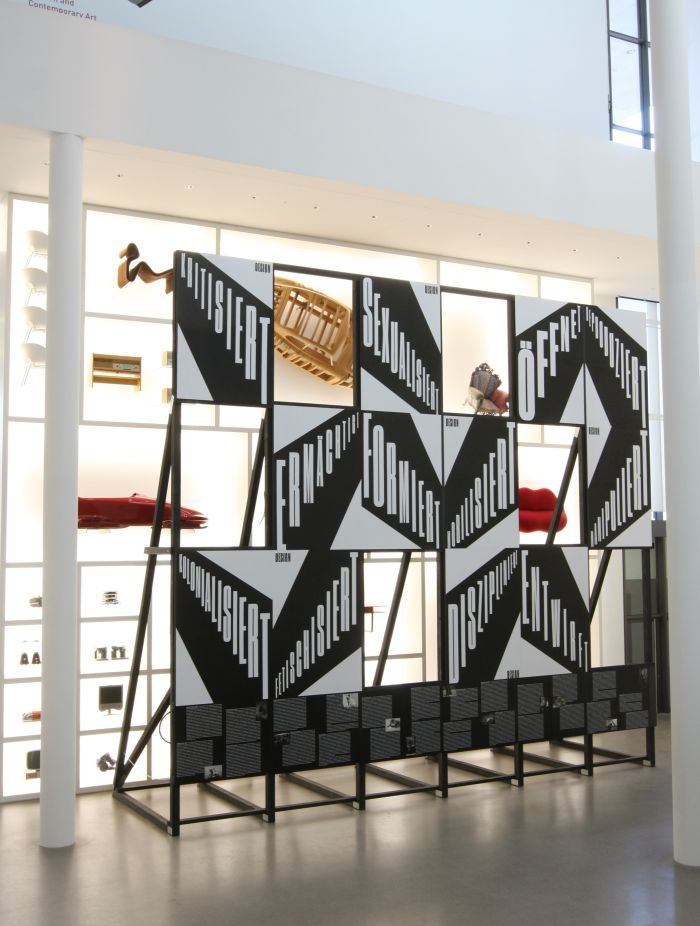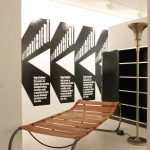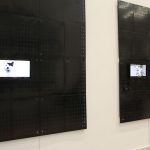Friedrich von Borries. Politics of Design. Design of Politics @ Die Neue Sammlung Munich
While a Chair of Politics is a long established academic principle, the chair as politics represents a much more contemporary understanding of, not just chairs, but all those artefacts with which we share our world and our daily lives.
With the exhibition Friedrich von Borries. Politics of Design. Design of Politics Die Neue Sammlung Munich explore, or perhaps more accurately, give architect and design theorist Friedrich von Borries free hand to explore, the intersection(s) of design and politics.
Although formally a continuation of the Neue Sammlung’s Paternoster Hall exhibition series, a series of longer-term exhibitions which allow an invited creative to discuss an aspect of design they consider relevant in a manner they consider appropriate, Friedrich von Borries. Politics of Design. Design of Politics begins not in the Neue Sammlung’s Paternoster Hall, but in the institution’s permanent collection exhibition where Friedrich von Borries has staged 9 interventions; interventions which employ the permanent collection as an intermediary to discuss design’s varying political aspects, including the positions that Design Colonises, Design Fetishises, Design Mobilises and Design Sexualises.
Whereby, it is always important to distinguish between overtly, deliberately, political design and inadvertent, unintentional, political design.
Objects such as the UP5 & UP6 armchair and ottoman by Gaetano Pesce, for example, which unequivocally challenge the accepted social role of females, or Stiletto’s Consumer’s Rest armchair, loving crafted from a shopping trolley as a critique on the furniture industry’s (profit driven) fascination with modernist functionalist aesthetics, being particularly pertinent examples of conscious political design; however, with most design, with most objects, the political nature of the design is not consciously inherent, but rather is bequeathed through context.
And as Politics of Design neatly underscores, the context in which an object exists can/does/must change, objects existing, as they do, in relation to social, economic, ecological, technological realities, as something that, as we noted in or calendar post on the Musée des Arts Décoratifs Paris’s 1969 exhibition Qu’est-ce que le design? exist as “a response to given parameters in a given time and space”, and therefore as a document of the time, space and realities, in which they were created. And as such prone to both evolving, and for all to new, interpretations.
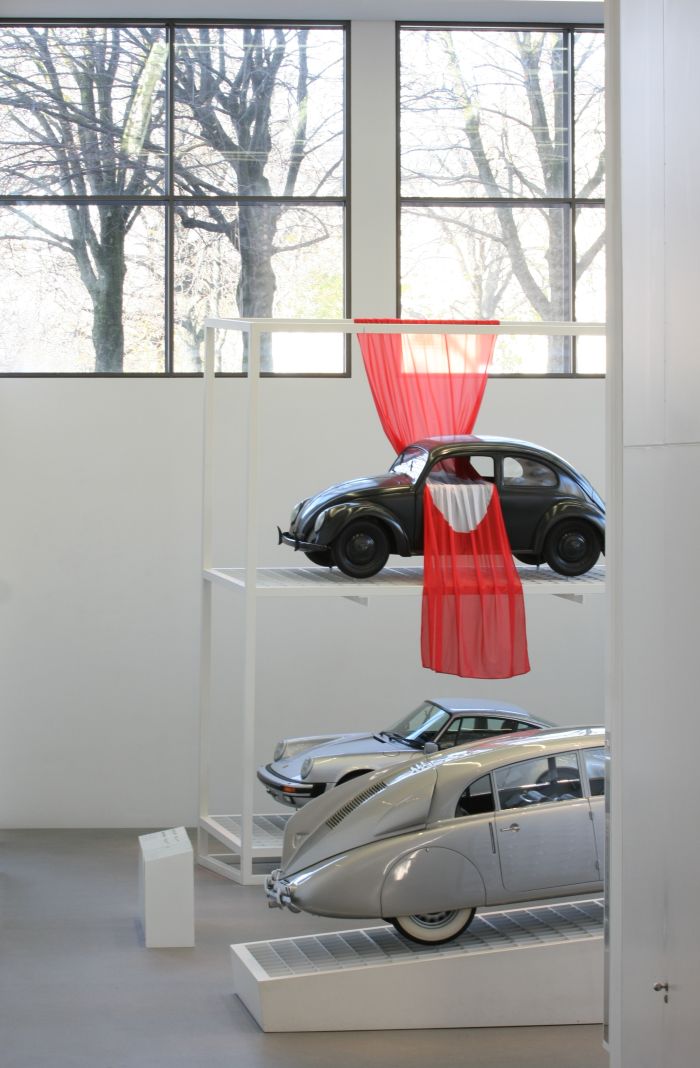
Design Mobilises with a VW Beetle, it’s not that flag, but it should give the impression it is, as seen at Friedrich von Borries. Politics of Design. Design of Politics, Die Neue Sammlung Munich
Isamu Noguchi’s 1939 Radio Nurse, for example is discussed under the title Design Manipulates as an entry point for contemporary digital surveillance, and that although Noguchi designed it as nothing more innocuous than a baby monitor to provide a little convenience and peace of mind for young mothers. But then, isn’t the promise of “convenience” and “peace of mind” that which underscores not only all contemporary state “security” measures, but also all Californian “smart home” devices? And are little more than a synonyms for surveillance.
Elsewhere one finds the VW Beetle as an object created by the Nazis for overtly political reasons, taken on by Hippies as an overtly political symbol of another kind, and thereby through its effortless interpretability existing as a universal symbol of the power of design to mobilise; the “LC” in Cassina’s LC furniture collection as representative of design reproducing and maintaining a dominant patriarchal hierarchy in society, standing as it does for Le Corbusier and thus ignoring the, not inconsiderable, input from Charlotte Perriand (and Pierre Jeanneret); or the UP5 & UP6 armchair and ottoman by Gaetano Pesce as an example of design sexualising and…..
…..Hang on! You just said that…..
….yeah, we know, we did, and for us the UP5 & UP6 are, and always were, about questioning the prescribed roles of women in society, about challenging accepted norms, objectification as an answer to sexualisation; that marketeers gladly make use of the chair’s soft curves, its classical, understated, monumentality and very prominent, tangible, deliberate, sexuality to try to sell a few more should come as no surprise. Sexuality being one of the lazier, and thus more regularly employed, marketing conceits. For all in furniture marketing where blurring the lines between design and lifestyle, intention and image, is a favoured deceit.
Friedrich von Borries sees the critical context more, well, critically, “Es wird kolportiert” the exhibition tells us in context of the works critical position, “Rumour has it”, and he may be right, we could be wrong, we regularly are: but one of the genuine joys of design is that one is continually forced to reconsider your position, one is continually faced with new understandings, new interpretations, new contexts, #metoo leads naturally to a reappraisal of Pop sensibilities, and through such evolutions a personal discourse with your own design position arises, and your understanding of design evolves. Whereby, we remain the view that Gaetano Pesce is on the correct side of history.
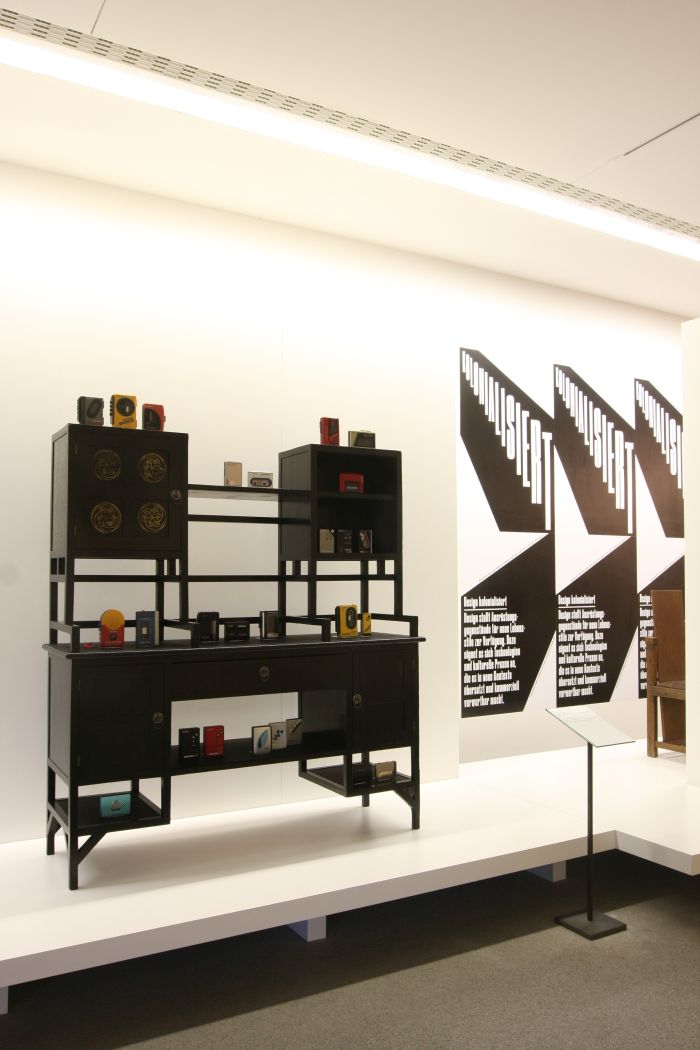
Design Colonises as exemplified by a Japan “influenced” 1867 sideboard by Edward William Goodwin and a whole load of Walkmans, colonisation often being a two-way street, as seen at Friedrich von Borries. Politics of Design. Design of Politics, Die Neue Sammlung Munich
With its at times extreme, often dangerously over extended, sometimes highly questionable, yet always thoroughly reasoned and elucidated, positions, and thereby the much freer discussions and discourses enabled, Politics of Design not only allows for a new, political, view of the objects in the Neue Sammlung’s collection, but through doing so also neatly underscores the paradox of the museal design presentation, something also discussed last year by Hella Jongerius & Louise Schouwenberg in their Paternoster Hall exhibition Beyond the New, and a paradox perhaps best surmised as Hella Jongerius did then, telling us that an artefact in a museum, “is not a thing that functions any more, not only doesn’t function as a thing on its own, but everyday things always exist in relation to other things and as soon as you isolate it from its function and social context it becomes an object. And how do you view a thing that has become an object, which has no value as an object?”*
Through adding the inherent, and constantly variable, political dimension Friedrich von Borries makes the paradox even more acute. Which isn’t to say a visit to a design museum is thus a pointless exercise, it never is and is something you should all do more frequently; is however to say it is important to understand that you are in a compromise situation, that what you are viewing is rarely as straightforward as that which you see. Which sounds like the start of a parable, so we’ll stop…..
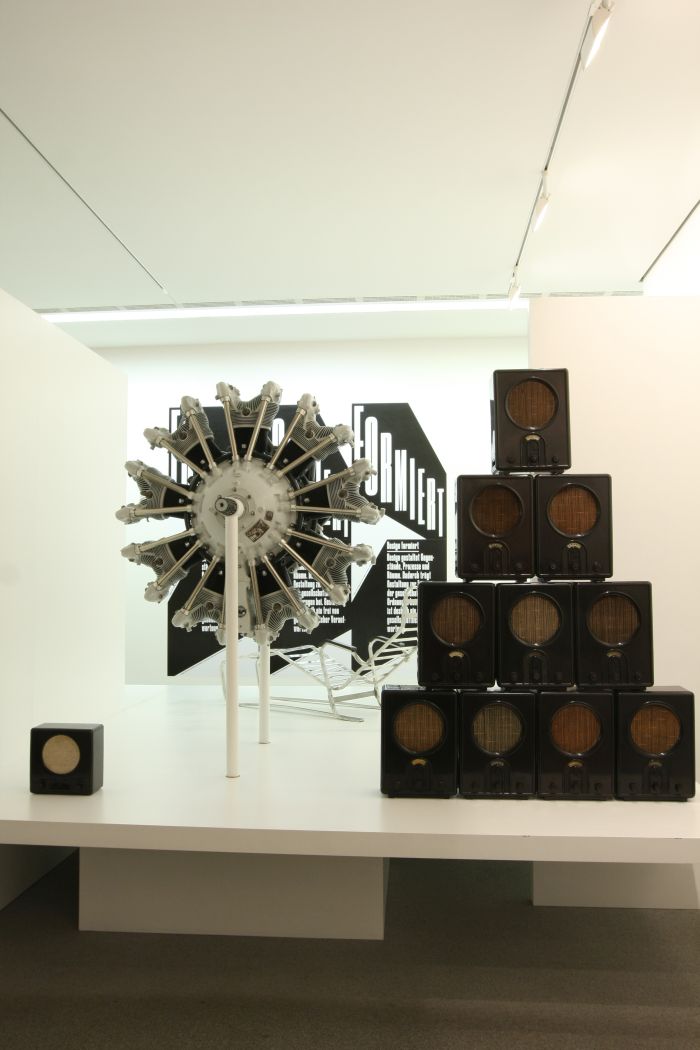
Design Forms with the 1928 Volksempfänger radio by Walter Maria Kersting, as seen at Friedrich von Borries. Politics of Design. Design of Politics, Die Neue Sammlung Munich
Whereas the majority of the interventions in Politics of Design involve highlighting political contexts in which design objects (can) exist, two are slightly more involved.
Design Disciplines sees Friedrich von Borries play with the German noun Sitz, seat/place/fit/settle, the chosen conduit for his discourse being the Thonet (2)14: that archetype of good seating design, the first mass market, consumer chair, and, according to Friedrich von Borries, a work whose regimented production method stands as representative for an enforced discipling of society enabled by design, and thereby not only of a design led regulation of society, but of a design led separation of society into “Besitzende” and “Besitzlose” – haves and have nots.
As a reaction Friedrich von Borries has reworked the familiar (2)14 backrest as a slide, an object which for Friedrich von Borries represents the “joyful transition from sitting to standing”, at the end of the slide coming an inevitable Aufstand. Up-rising. While the frame and steps are wood, the slide itself, as it were the functional part, the part that leads from oppression to freedom, is crafted from finest papier-mâché. Which on the one hand neatly links it to the 19th century development of lacquered papier-mâché “Japan ware”, a development which, and to stay in the exhbition’s vocabulary, stands representative of design colonising, and a development that occurred parallel to Michael Thonet’s development of design as a discipliner.
And also a material choice which means the slide can’t function. But then being a design museum exhibit, no one notices. And it looks great!! We’ll get that on Instagram!! And quite aside from its position in context of Politics of Design, we’re really looking forward to seeing how Die Neue Sammlung integrate it into their forthcoming Thonet exhibition……
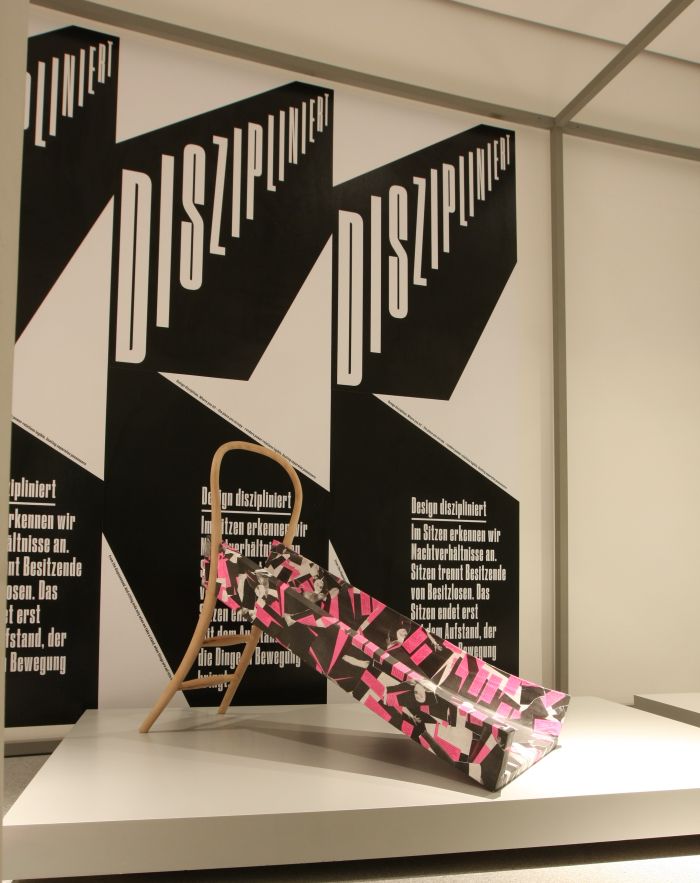
Design Disciplines as challenged by a Thonet slide, as seen at Friedrich von Borries. Politics of Design. Design of Politics, Die Neue Sammlung Munich
Beyond the interventions in the permanent exhibition Politics of Design also sees Friedrich von Borries add to the permanent collection. Ahead of the exhibition an Open Call was made for objects created by the public, a jury, composed of all those who had submitted projects, collectively considered the submissions and selected 12 for inclusion in the exhibition including an open design Fairphone case by Fabian Hesse, the Elektroklon twitterbot by Ilona and Robert Meisenecker and the Rolling Garden project by Helge Wiedebusch.
Presenting the selected objects alongside, and in full equality with, established design “classics” the Design Empowers presentation quite deliberately poses the question, what is design? A not irrelevant question in a design museum, especially one claiming to be the world’s oldest and home to one of the world’s largest design collections. What is design?
And for all who decides?
Museums? Manufacturers? Marketeers? Media?
And is there a check in the system?
In context of art the American art critic Arthur Danto opined that, “to see something as art requires something the eye cannot decry – an atmosphere of artistic theory, a knowledge of the history of art: an artworld.”1
Or put another way, experts decide and tell you what art is; a topdown understanding of art.
And in many regards that is what we have in design: blogs, magazines, newspapers, TV, radio tell us what design is; PR companies tell us what design is; brand managers, sales reps, online shops tell us what design is; and museums put it on pedestals to confirm that it is design.
Which obviously is a thoroughly unsatisfactory system. One which may, more or less, be applicable for passive art works, but in context of active design, be that functional objects of daily use or systems which define our paths through bureaucratic and civil structures, such a method of defining design cannot possible serve its function. Not least because of the facts that (a) most design isn’t the result of a single creative moment but of a process in which numerous members of the expert designworld network have an input, and (b) the commercial context in which most design objects exists and the associated pressures within the designworld to ensure that the “right” objects are “properly” classed as design. Although the latter is arguably also true in Danto’s artworld
Through sidestepping the conventional expert network and employing a, for want of a better description, lay expert network, Friedrich von Borries has allowed for a differentiated view of design, a view of design devoid, or at least independent of, the inherent biases in the designworld; which doesn’t make it any “truer”, not least because it is still prone to the pitfalls of fad and t****, yes we did see the “H” word, yes we did get cross; however, the chosen process does neatly underscore the imperative of us all developing our own understandings of design, not only as a check on the vagaries of the designworld but for all to enable us to surround ourselves with objects that meet our understandings, and not those imposed from above, potentially for mercantile reasons.
Something that, yes, by necessity involves exposing yourself to (a little) theory and history, but for all involves considering design not solely as a commercial good, something to buy and show off, but also as a cultural good, as something arising in, and reflective of, a particular constellation of contexts, yet not fixed but liable to change as the individual contexts of its genesis, and their relation to one another, change.
Politics of Design is a good place to do just that. And why you should do that becomes clear at the end of the tour through the permanent collection, in the Paternoster Hall.
The empty Paternoster Hall.
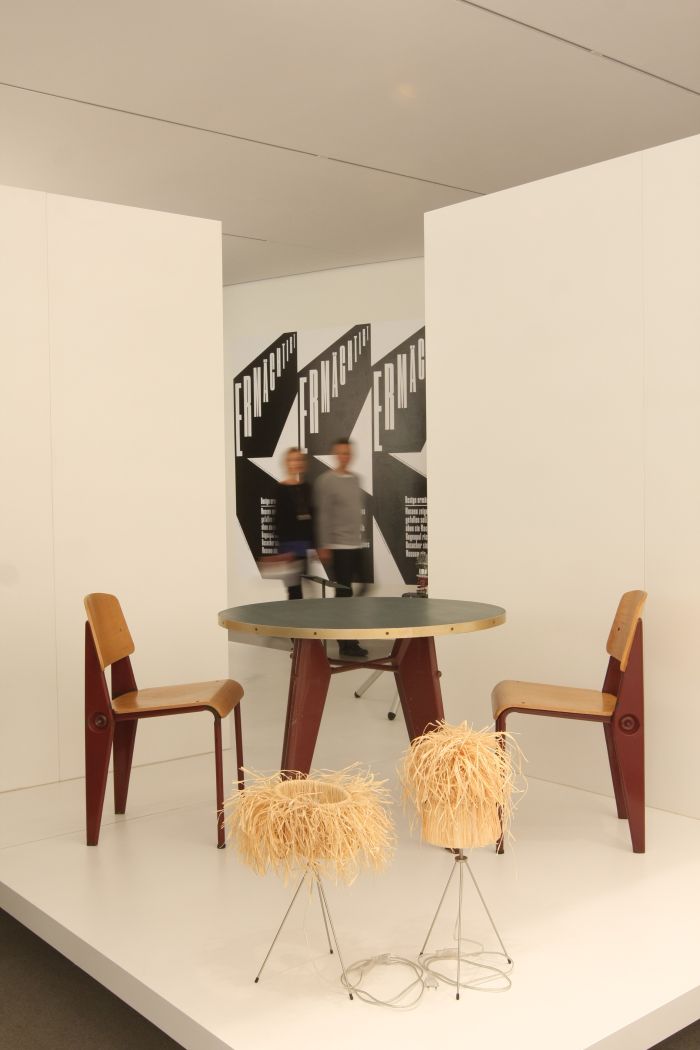
Design Empowers, featuring the Max & Moritz lamps by Sophia Louisa Vandré alongside works by Jean Prouvé, as seen at Friedrich von Borries. Politics of Design. Design of Politics, Die Neue Sammlung Munich
OK, not empty empty.
For much as John Cage’s composition 4’33” isn’t four an half minutes of silence, but four and half minutes of the sound of an audience listening to four and half minutes of silence, so to is the apparently empty space in the Paternoster Hall reserved for considerations on where design could/should/must intervene in political processes.
Currently the most visible form of design in context of political systems is, arguably, social design, the “Politics” in the title of the Vitra Design Museum’s exhibition Victor Papanek. Politics of Design being Papanek’s social activities. In Design of Politics Friedrich von Borries convincingly argues design can/should/must involve itself with all processes that combine to compose the body politic, that, if you will, just as design isn’t something that should be decreed topdown, neither is politics; his central arguments being presented through four videos, videos in which his words are spoken not by himself, but by ………. cats.
No honest.
And logical. Because we all pay attention to cats, or at least do if the number of cat pictures on the internet stands in any realistic relation to the relevance of things on the internet. And, we’d argue, cat pictures are also deeply political, for, and as we all learned from the exhibition Buy Now, Pay Later at MAD Brussels, keeping all those pictures of cats online requires the most absurd waste of energy, something we as a society are obviously happy to accept. Preferring as we do pictures of cats to polar ice caps.
Focussing on four broad subjects areas, Reference Space, Daily Life, Organisation and Symbolism – the latter being spoken by a very convincing Hitler Cat discussing subjects such as the Bundesverdienstkreuz [Germany’s medal for public service and whose form is based on Nazi era medals], the military receptions given to foreign leaders when they visit Germany, and ballot boxes – the key to the Design of Politics presentation is less Friedrich von Borries’ positions and more the framework created.
A framework which offers the opportunity, and space, for further considerations on the function/role/necessity of design in political systems, something which not only all visitors are encouraged to do, but which will be augmented and advanced by a series of workshops; and thereby a framework for filling the otherwise empty(ish) Paternoster Hall with a, hopefully, broad, diverse, yet well grounded, mix of opinions on the politics/design/politics interface, and thereby not only stimulating a public discourse on political systems, but enabling the exhibition to have an existence, and relevance, beyond its nine month run and accompanying catalogue.
And a part of the exhibition we will return to later, once it has developed.
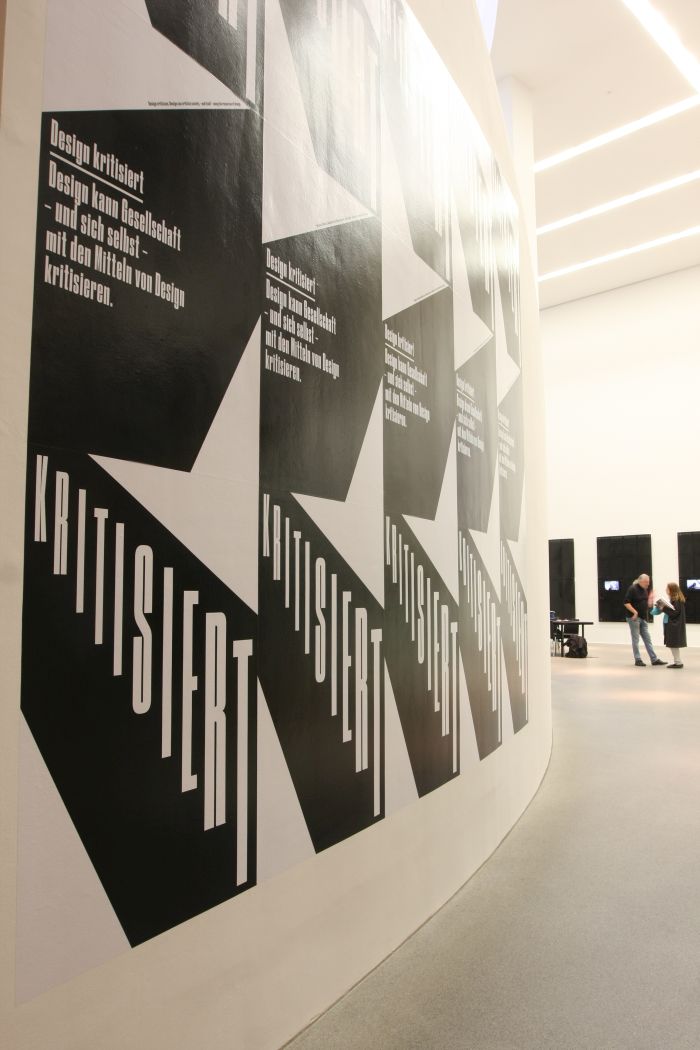
Design Criticises, and thereby enables discourse, as seen at Friedrich von Borries. Politics of Design. Design of Politics, Die Neue Sammlung Munich
If we’re being honest, which we always try to be, we did approach the Politics of Design. Design of Politics with a little, quite a lot, of trepidation: we’ve viewed previous Friedrich von Borries exhibitions, exhibitions which were often very conceptual, one in particular which we are still struggling to decode, and we feared a similar presentation in Die Neue Sammlung.
O ye, of little faith!
Through the intelligent, well considered, and pleasingly reserved, use of the relatively simple intervention tool, Politics of Design allows for an exhibition which can be approached on many levels, from a superficial “a-ha, look at that, who’d have thought”, to a more in-depth consideration on the validity, or otherwise, of Friedrich von Borries’ positions. And which no, in context to what we’ve noted above, isn’t a contradiction.
Yes there is a lot of, necessary, theory, but the open, accessible presentation format and concise, jargon-free, bilingual English/German texts ensure that, for example, you don’t have to know about the (overtly political) history of Michael Thonet’s patents to enjoy the Thonet slide, nor to understand and enjoy the exhibition as a whole do you have to be familiar with the (hi)story of international modernism, the post-Sakoku dissemination of Japanese aesthetics, the Cold War propaganda contributions of American Mid-century Modernists, the relations between the development of the Swedish welfare state and design in Sweden, the fineries of colonial era tropical wood harvesting, the complexities of being a female architect/designer in the early 20th century, the links between the Operaismo strand of Marxist theory and Italian radicalism, etc, etc, etc
Although obviously, and as noted above, we’d encourage you all to learn about such things.
Similarly the space left in the Paternoster Hall means you can either skip quickly through it on your way to café, or invest the time to properly consider and contribute to the topics and positions. Which, again, we’d obviously encourage you all to do.
Yet regardless how you approach it, viewing Friedrich von Borries. Politics of Design. Design of Politics will/should alter the way you not only consider Die Neue Sammlung’s collection, and, hopefully, by extrapolation all design museum collections, but for all confirm the truth that just as, and as we oft repeat, design isn’t a profession open to a few but a way of thinking open to us all, similarly politics isn’t a profession open to a few but a mode of action open to us all.
And a political chair isn’t a profession, but an embodiment of the inherent connection and perpetual interplay between design and politics.
Friedrich von Borries. Politics of Design. Design of Politics runs at Die Neue Sammlung, Pinakothek der Moderne, Barer Straße 40, 80333 Munich until Sunday September 29th.
Full details, including information on the accompanying fringe programme can be found at https://dnstdm.de
Details on the workshops can be found at www.basislager-demokratie.de
* in the interests of clarity, in context of Beyond the New Jongerius and Schouwenberg distinguished between “objects” in museums and “things” we use….
1. Arthur Danto, The Artworld, The Journal of Philosophy, New York, Vol. 61, No. 19, 1964
- The Paternoster Hall, as seen at Friedrich von Borries. Politics of Design. Design of Politics, Die Neue Sammlung Munich
- Design Sexulises with Afri-Cola advertising, as seen at Friedrich von Borries. Politics of Design. Design of Politics, Die Neue Sammlung Munich
- Design Empowers, featuring Kissen by Gabriele Hüttl & 3D Edu Klit by Mitra Wakil alongside the String system by Nils Strinning, as seen at Friedrich von Borries. Politics of Design. Design of Politics, Die Neue Sammlung Munich
- Design Fetishises witha the 1931 LS 22 lounger by Hans & Wassili Luckhardt with Anton Lorenz, as seen at Friedrich von Borries. Politics of Design. Design of Politics, Die Neue Sammlung Munich
- Design Empowers, featuring the Rolling Garden project by Helge Wiedebusch, alongside a sideboard by Charlotte Perriand, as seen at Friedrich von Borries. Politics of Design. Design of Politics, Die Neue Sammlung Munich
- What better partner for a discussion on political symbolism could you wish for, as seen at Friedrich von Borries. Politics of Design. Design of Politics, Die Neue Sammlung Munich
Tagged with: Die Neue Sammlung, Friedrich von Borries, Friedrich von Borries. Politics of Design. Design of Politics, München, Munich, Paternoster Hall exhibition
